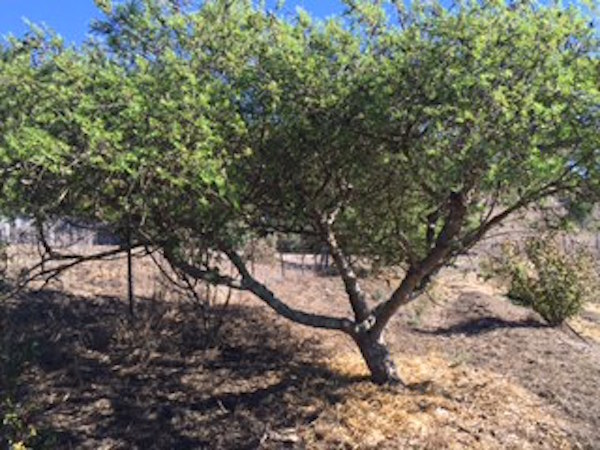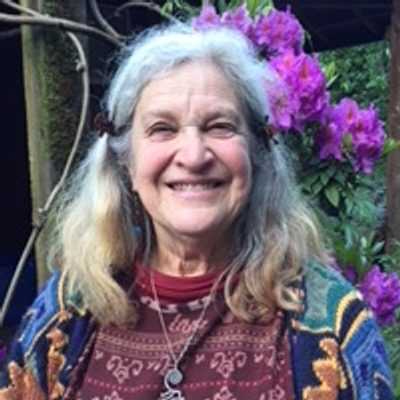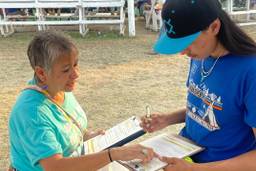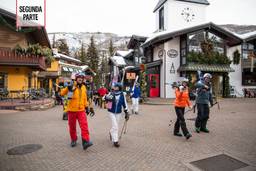Why a California Dairy Goat Rancher Doesn’t Owe Her Soul to the Company Feed Store
Patty Karlin
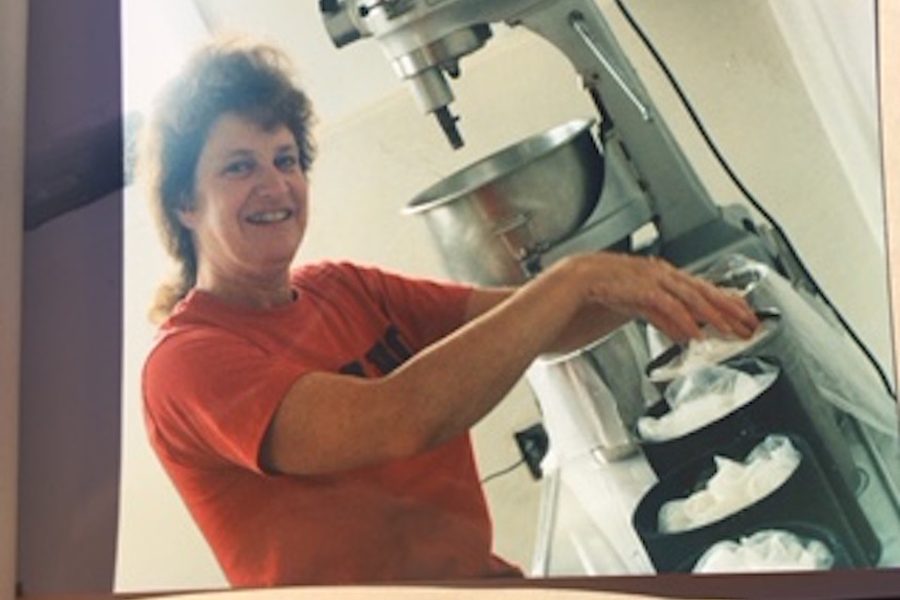
In 1967, as a young woman in my early twenties, a “tipping point” (in the Malcolm Gladwell sense) occurred in Paracuru, the fishing village in northeastern Brazil, where the Peace Corps had sent me. At the time, Paracuru was one of the poorest places on Earth. I was helping a nun named Fabiana, a self taught midwife, deliver babies in grass shacks with dirt floors. The husband would sit on a low birth stool supporting his wife’s hips while Fabiana and I would deliver the baby.
The women of the village were still carrying water in gourds on their heads, so we established a community garden at the church’s well. Using beds raised on stilts to increase aeration and prevent insect devastation, we were able to scratch out more vegetables from the poor, dusty soil.
I began to realize that the two things I was engaged in — nursing and farming — were so vital, that the other endeavors I had been considering for my future looked pale in comparison.
Flash forward 17 years: Having completed an RN and MPH, I was working at University of California San Francisco Medical Center in the neonatal intensive care unit when I met my second husband, Javier.
We wanted to bring his parents to the United States from Peru, but were at a loss as to what his father, a 60-year-old agronomist and cheese maker would do once he arrived. Although he had always worked with cows, the amount of land required to raise them was prohibitive, so we bought a herd of goats, rented land outside of Berkeley, and started milking goats and making cheese.
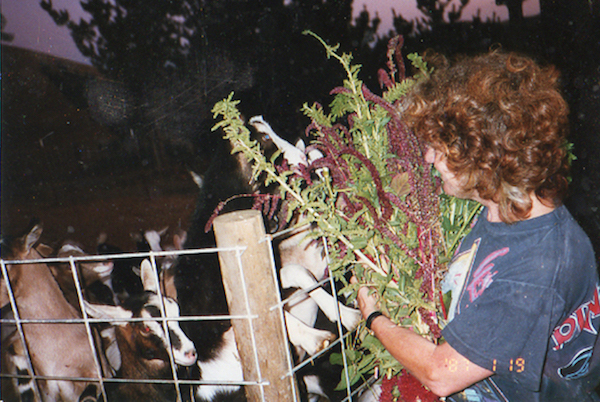
Feeding time in the early days of Patty and Javier’s cheese making operation. (Photo: Bodega Goat Ranch)
The reckoning
When Javier’s parents arrived, my father- in-law took one look at our books and said, “No one will ever make money at this, even tripling the amount of cheese you make.” He went on to other endeavors, but we were already hooked on goats. Six months later, in 1985, we found 7.5 acres near the town of Bodega in Sonoma County and moved our herd and ourselves out to the country, north of the Bay Area. We substituted goat milk in several of Javier’s dad’s cow recipes to produce a fresh mild cheese that was much beloved by our clients, and Bodega Goat Ranch was born.
Unfortunately, my father-in law’s prediction came true. Although we became a fully certified Grade B Dairy — producing 150 pounds of cheese a week for 9 months out of the year — we spent the next 12 years working our other “careers” to support what the Department of Agriculture designated a “hobby farm,” i.e. a smallholding that is maintained without expectation of being a primary source of income.
In 1996, we were able to quit our outside jobs and go full-time with Bodega Goat Cheese. At this important juncture, however, we had to decide whether to greatly expand the plant — buy more equipment and hire many more employees — or stay a more modest size and realize a profit through decreased costs. Having already doubled production volume since quitting our outside jobs, we elected to do the latter. We stayed the course for the next 8 years, until Javier and I went our separate ways in 2004.
I decided to remain on the ranch.
On the one hand, now on my own, I needed to find more help, but also realized that, to ensure quality, I needed to continue making the cheese. I also wanted to downsize the scope of the operation so I could keep it going by myself.
To solve this dilemma, I turned to a concept I call “team farming.” Many young people are serious about farming but unable to pursue it because of the cost of land. By allowing young farmers to establish their own ventures on my seven-and-a-half acres — and by providing housing — I was able to “diversify” — maximize the use of the space — and get help with the goats.
Another goal was to develop the land in order to solve the water problem. In Sonoma County we get rain only over a three-to-four month period — 60 inches in a normal year, but only 29 in drought years. If we were able to sequester that rainwater, we would be able to grow all the feed for the animals and stop buying commercial feed.
Words such as “green,” “organic” and “biodynamic” have entered the public vernacular. Were you to ask the person in the street their meanings, however, many would be unsure how to definitively reply. “Sustainable,” for which I consider my farm to be a model, is perhaps the most common buzzword at the moment. Here are two plausible interpretations, though I’m sure there are others:
1) the ability to continue what you are doing indefinitely without the depletion of the earth or sentient beings;
2) the three E’s; economic (the farmer earns a living and can cover his/her bills), environmental (no negative impact) and educational (help others learn how to do this too).
Drought and regulation
Our current drought, now in its fifth year, has caused the cost of feed to skyrocket. Many farmers are being forced to sell off their livestock. If I pay $20 for a bale of alfalfa for example, a goodly percentage of that is the cost of hauling it in a gas guzzling truck from further and further away. Once it gets to the town closest to me, I pay a delivery fee to haul it up to my hay barn and then a labor fee for farm help to feed it out to the herd twice a day. For 50 to 60 goats, the cost is about $15,000 per year. In addition, the United States is the only country that requires the farmer to pay the Department of Agriculture’s inspection fees, which are required to run a certified dairy.
Increasing government regulation costs upwards of $2,000 for the inspections, not including the additional cost of any required “improvements.” In spite of these increased costs, these same officials, due to state budget cuts, have greater caseloads and are less available. When we started 30 years ago, our inspector showed up every two to three weeks. Now we see our inspector once every three months — the legal minimum.
We built our entire facility from an existing barn, but outfitted it to meet USDA standards. Back then, by doing most of the work ourselves, we were able to accomplish this for around $10,000. Today, for those trying to “pass” 2015 requirements, it costs about $100,000 just to build a cheese plant (whereas we also have a “milking parlor.”) In addition to the California Department of Food and Agriculture, it is now necessary to register with the USDA, a Homeland Security requirement, as cheese is a perishable item, and considered in the domain of possible bioterrorism.
Two other agencies that have come to visit are the California Department of Health and California OSHA. If you wish any additional designations on the label, such as “organic” or “kosher,” those require separate inspections and separate fees of at least $1,000 per year each. Additionally, if you sell produce at farmer’s markets, you must register with the Environmental Health and Safety division, in each county in which you participate. For a small farming enterprise, the regulations are onerous. Indeed, since most of the problems to the food supply have originated in larger, mechanized, “industrial” facilities, it begs the question of why the smaller concerns (such as mine) should be treated in the same way and not prorated more fairly.
Besides government regulation, another prohibitive factor for small farmers is outside inputs. Just as miners became indebted to the “company store,” many small farmers become indebted to the company feed store, which then charges 18 percent on the debt incurred.
A sustainable future
In his eye-opening book, The Power of Duck, Takao Furuno describes the traditional Japanese methods of integrating ducks into rice paddies to both fertilize and control pests without any purchased chemical products.
For the past 11 years, I have been following the principles of permaculture, which Rosemary Morrow in her book the Earth User’s Guide to Permaculture describes as “an approach to land use which weaves together microclimate, plants, animals, soils, water management and human needs into intricately connected, productive communities.” By doing so, I have been implementing methods that will allow me to raise up to 100 goats on my seven-and-a-half acres, with practically no inputs from the outside world. Much of the infrastructure is already complete.
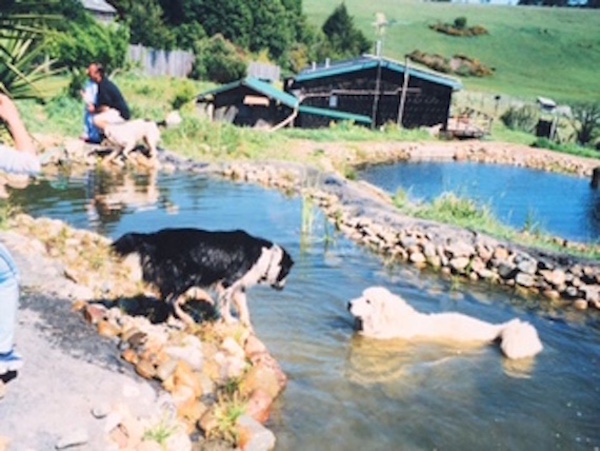
By repurposing the farm’s old manure basins — lining the bottom of one with rubber and covering the surfaces of all of them to prevent evaporation — Karlin can store enough annual rainfall (even in a drought) to meet her farm’s water needs. Potable water is stored in two 5,000 gallon tanks. (Photo: Bodega Goat Ranch)
First, an excavator dug six-foot wide canals to the contour of the hill to maximize the capture of rain water. Then he backfilled those canals with the excavated sandy soil to act as drainage rock. In addition, he cleaned out old manure ponds, which created a total water holding capacity of 80,000 gallons. We put a rubber liner in the pond at the top of the property for water retention through the dry season. These ponds and canals fill with rain from the sky, but can be improved on in the future by being fed from the rain gutters on the farm’s roofs. Retaining water in such a way, even the paltry 29 inches of rain that fell last year, is enough to supply all our needs.
A small well is sufficient to fill two 5,000 gallon tanks for all our potable water, which passes through a UV light and is ozonated to kill bacteria without chlorinating.
Once our ponds are covered to prevent evaporation, we will have enough water to provide drinking water for all the animals (the farm also has chickens and ducks and honey bees) and grow enough plants to feed all of them solely from our land.
Since goats “browse” like deer, their natural diet is trees and shrubs — not pasture like sheep and cows. And it turns out we have sufficient land to raise enough trees to provide all the food for 50 to 80 goats. Since they will eat in place, the labor cost of distributing feed will be eliminated. To prevent the goats from stripping the bark or destroying the trunk of the trees we’re planting, we will put on a protective sleeve, so they can prune all the horizontal branches without decimating the supporting trunk. By standing at the base of the tree, they will also be “fertilizing” it as they eat.
In addition to the trees, which will all but eliminate the need for any commercial hay, we have built a 10-by-10 greenhouse for a project called “fodder solutions.” Following models developed in Australia (which has pioneered many water saving and water recycling methods), I will be buying organic barley seed to sprout on nursery trays in the greenhouse. Instead of buying commercial grain (barley in the case of dairy goats), this seed is one sixth the cost of the feed store grain. Once sprouted (which takes just six days to be able to feed out like sod) it has four times the protein as the original seed. Since the tops stay green, unlike pasture which dries out, the mamas don’t drop their milk production. The seeds are watered hydroponically, with each tray dripping onto the shelf below, and then all water is collected at a drain below and sent out to the goats for their drinking water.
The trees themselves should be of a great variety, but we consulted Ag Access at University of California at Davis to determine what species would be most beneficial. Inquiring about the nutritional analysis of an optimum goat diet, it turns out that one tree in particular stood out, a tree lucerne or tagasaste. Originally from the Canary Islands but now grown extensively in Australia, tagasaste is a member of the legume family and as such produces seed pods and is a nitrogen fixer.
The nutrious foliage of drought-resistant tagasaste trees will be able to feed Karlin’s goats throughout the year. (Photo: Bodega Goat Ranch)
The tree is planted on the lower edge of the canals, providing shade to prevent water evaporation. It puts down a 40-foot taproot within two years, hitting ground water. It’s leaves rival alfalfa in protein and nutritional content, but is more digestible for goats. Since it has vertical growth it is non-invasive, although it is a non-native species. Alongside them, we will plant native trees that do well locally — ceonothus, willow, poplar, non-fruiting mulberry, honey locust, Douglas fir, coyote bush, amaranth, quinoa and medicinal shrubs.
I believe that the above methods will enable Bodega Goat Ranch to be truly self-sufficient, while providing all the food needed to maintain a small farm and at the same time generate a surplus for the market that will provide income. By thinking out of the box, we will create a small-scale, replicable alternative for small farmers anywhere, no matter which plants and animals they wish to cultivate. It is an alternative to industrial, mechanized farming, enabling earnest individuals to make a decent living while providing the highest quality food.
